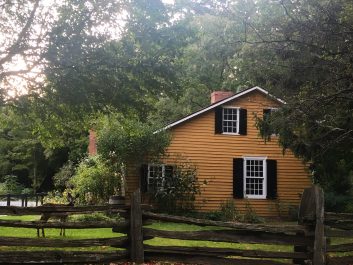Check Out Mississauga’s Historic Neighbourhoods and Landmarks
Check out a few of Mississauga’s historic neighbourhoods and landmarks.
Entertainment and activities | October 17, 2019
Since the City of Mississauga was incorporated in 1974, it has grown to become Canada’s sixth largest city. Mississauga grew from several historic villages, with some disappearing over time and others continuing to exist today. Each neighbourhood is steeped in historical significance and provides endless opportunity for discovery. Check out a few of Mississauga’s historic neighbourhoods and landmarks.
Clarkson
Many consider Clarkson to be Mississauga’s first settled area, with settlement in Clarkson beginning as early as 1807. Clarkson is also home to two heritage houses that are open to the public: Bradley House and Benares Historic House.
Bradley Museum
Located within a 70-year-old maple grove, the Bradley Museum Complex consists of four buildings, three of which are designated Ontario Heritage Sites. The Bradley House itself was built in 1830 and continues to stand on the original property owned by the Bradley family.
Until November 17, check out the Mississauga Miracle Exhibition at the Bradley Museum to see archives and artifacts from the 1979 Mississauga Train Derailment.
Benares Historic House
Home to four generations of the Harris family, the Benares Historic House was originally built in 1835. It currently houses the impressive Harris Family collection, with more than 95 per cent of the artifacts in the house being original to the family and home.
Visit the Bradley Museum and Benares Historic House from Thursday to Sunday from noon to 4 p.m.
Streetsville
With settlement beginning around 1819, Mississauga’s ‘Village in the City’ became a bustling centre for political and economic activity. Today, Streetsville is home to Mississauga’s largest collection of historic buildings, including the Leslie Log House, as well as two City-owned, historic cemeteries.
Leslie Log House
Designated under the Ontario Heritage Act, the Leslie Log House is home to the Streetsville Historical Society and Archive. The house maintains its original structure and provides a rare example of log construction from the early nineteenth century.
Visit the house on Wednesdays and Sundays from 1 to 4 p.m.
Cemeteries
The Streetsville Memorial Cemetery is a local landmark and an integral part of the Streetsville community. With burials beginning in 1824, the cemetery is rich in history. The land was provided to the Presbyterian Church by Timothy Street, after whom Streetsville was named.
The Streetsville Public Cemetery was established in 1892 after the Streetsville Memorial Cemetery reached capacity. Overlooking the Credit River, the cemetery provides a park-like setting, with mature trees and beautiful landscaping. The cemetery continues to serve the Streetsville community today.
Lakeview & Port Credit
Small Arms Inspection Building
Located on Mississauga’s eastern waterfront, the Arsenal Lands became the site of a large munitions plant in 1940, which manufactured rifles and small arms for the Canadian Army until 1974. The Small Arms Inspection Building now hosts a variety of art exhibits and creative programs that are open to the public.
Port Credit Cenotaph
The Port Credit Cenotaph, the oldest cenotaph maintained by the City, was first unveiled on November 9, 1925. The cenotaph honours those who served in World War I, World War II and the Korean War.
For more information about Mississauga’s historic museums and landmarks, visit mississauga.ca/culture and mississauga.ca/parks.
Media contact
City of Mississauga Media Relations
media@mississauga.ca
905-615-3200, ext. 5232
TTY: 905-896-5151
